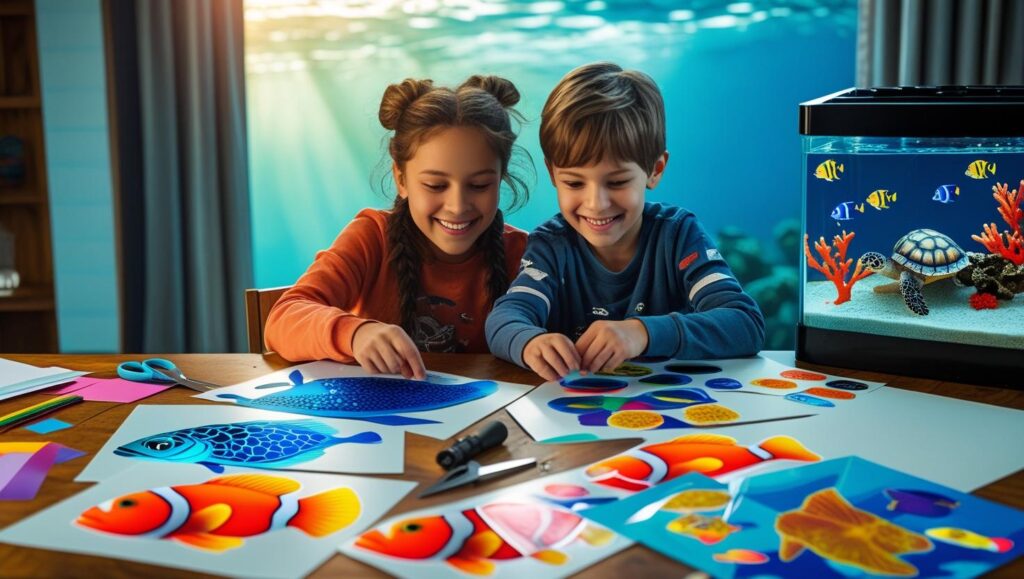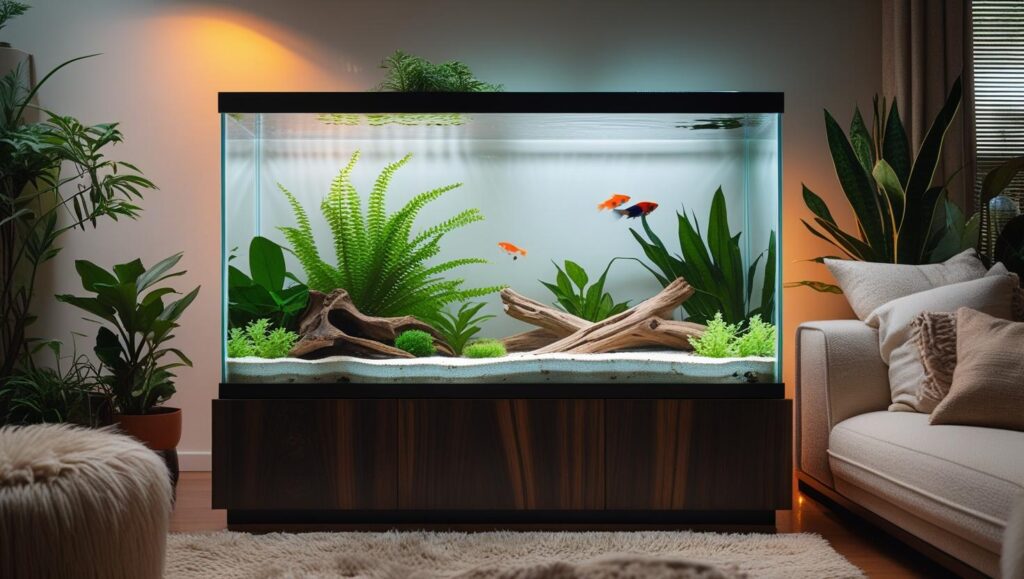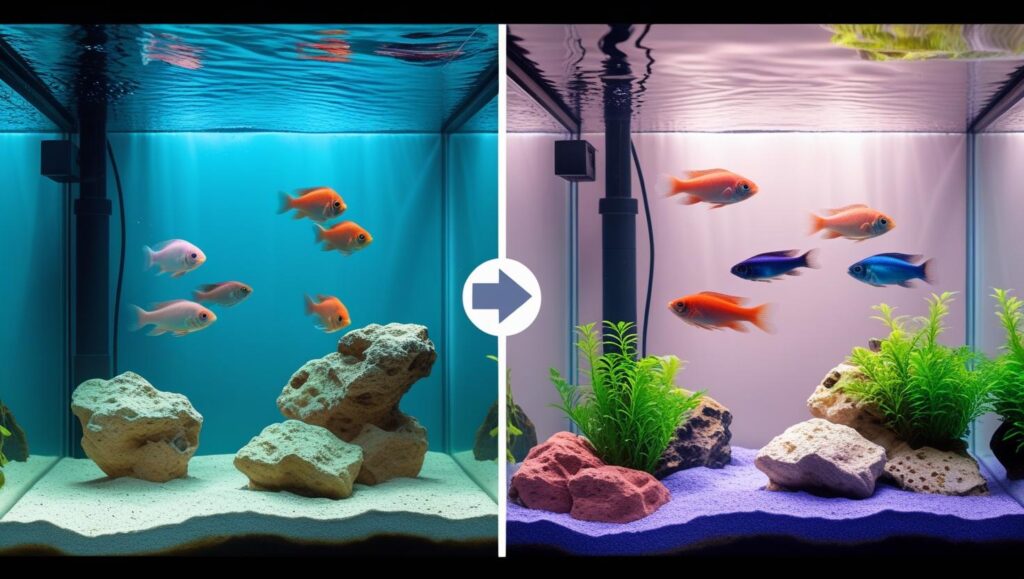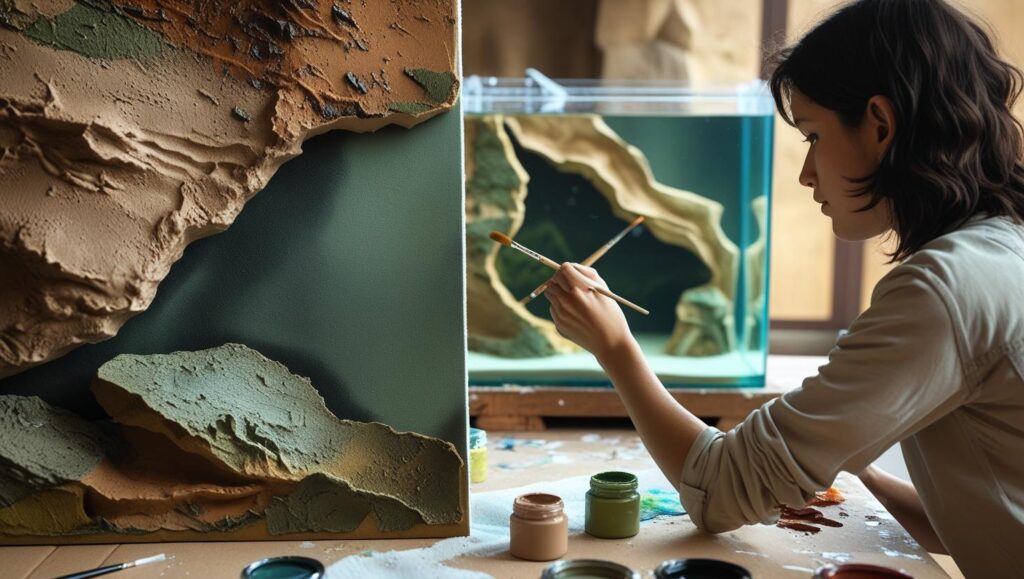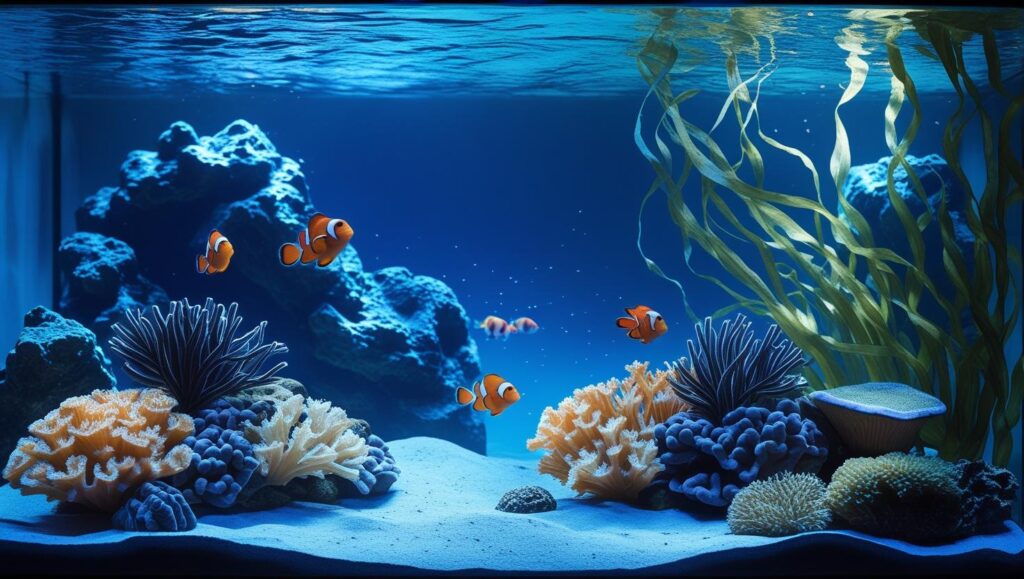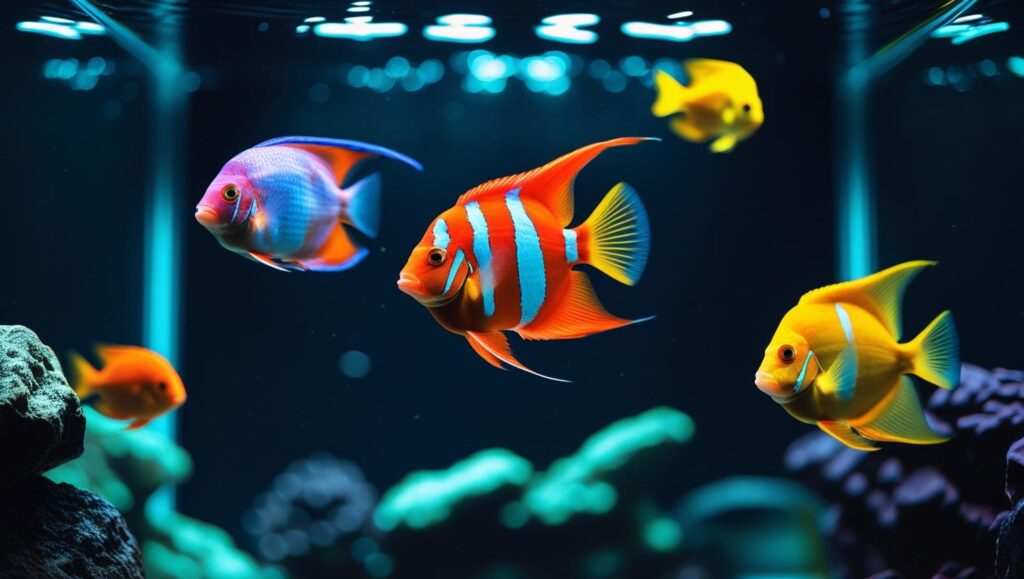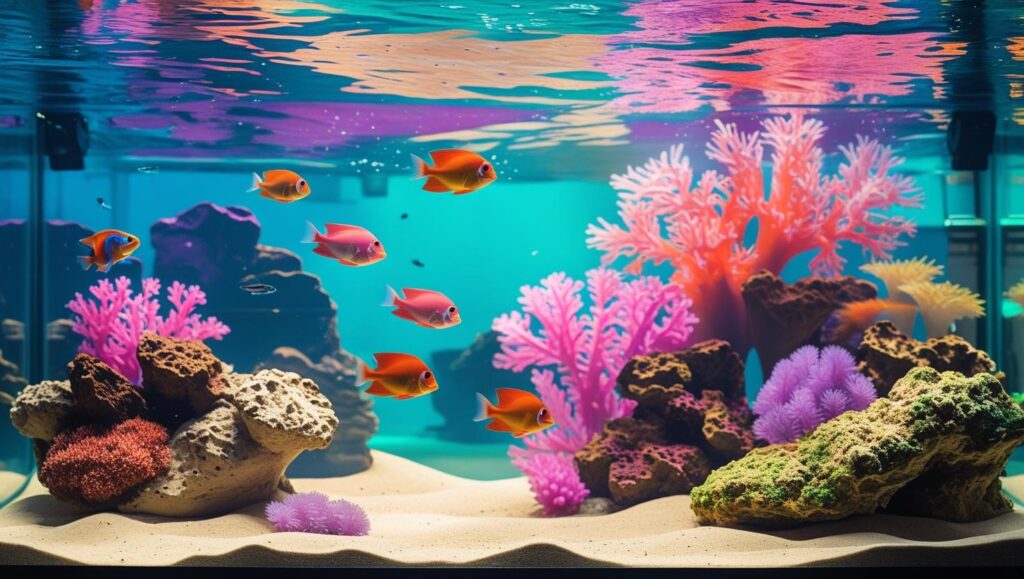How to Use an Aquarium Mirror Background Like a Pro
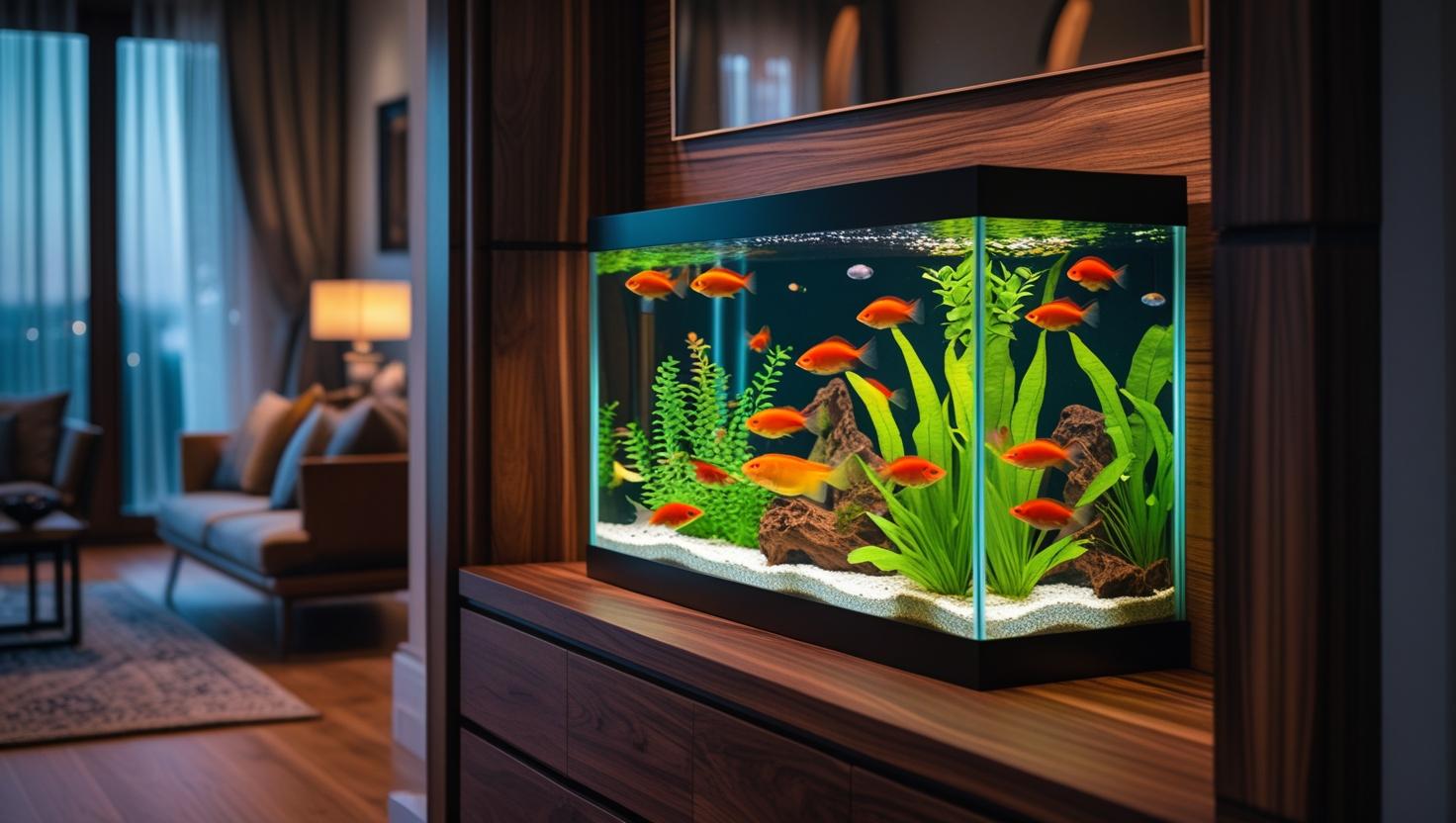
Ever looked at your aquarium and felt like something’s missing, like it needs just a bit more life, light, or dimension? You’re not alone. I remember the first time I added a mirror background to my tank, it was like unlocking a whole new world underwater. Suddenly, my fish looked like they had double the space, and the tank seemed to glow with depth and movement. If your aquarium feels a little flat or dull, a mirror background might be the simple upgrade you didn’t know you needed. In this post, you’ll learn how this reflective touch can transform your setup, the pros and cons to consider, and even how to DIY your own. Let’s make your tank look twice as stunning, without twice the effort.
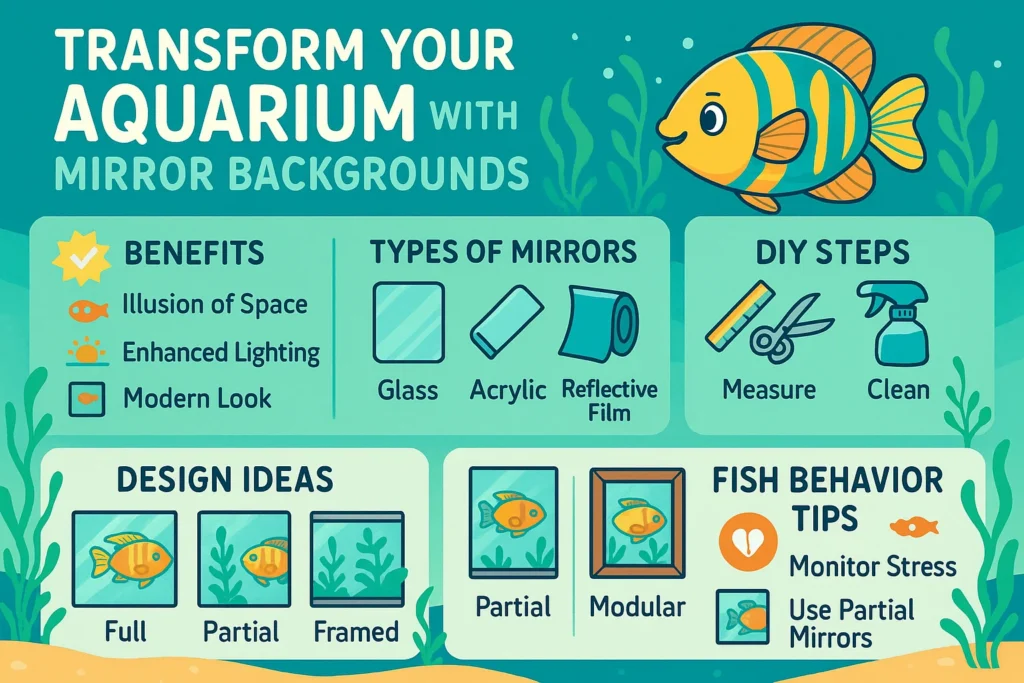
What Is an Aquarium Mirror Background?
An aquarium mirror background is a reflective panel placed behind your tank to make it look bigger, brighter, and more lively. It reflects everything inside the aquarium, creating a beautiful illusion of depth and movement. This simple addition can instantly elevate your tank’s look, making even a small setup feel more dynamic and spacious. It’s not just about looks either. A mirror background can boost light levels and give your fish a livelier environment.
When I first set up my 20-gallon tank, something felt off. The layout was nice, the plants were thriving, but it still looked…flat. A friend casually mentioned trying a mirror background. I was skeptical, but I gave it a shot. The change was immediate. The tank looked deeper. The fish seemed more active. Even the lighting felt enhanced. That little tweak made the whole setup feel more alive.
Let’s explore the different types of mirror backgrounds so you can find the one that fits your tank perfectly.
Types of Aquarium Mirror Backgrounds
There are a few main types of mirror backgrounds, each with their own perks. Glass mirrors are the most traditional. They’re sturdy and offer a sharp, clear reflection. Acrylic mirrors are lighter and shatter-resistant, which is perfect if you have kids or pets around. Reflective film is the easiest to apply. It sticks right onto the back of the tank and is budget-friendly too.
I personally started with a reflective film. It was easy to cut, peel, and stick. At first, I wasn’t sure if it would hold up. But months later, it still looked great. Eventually, I upgraded to an acrylic mirror when I changed tanks. It gave the same beautiful reflection but felt more solid and long-lasting. For me, it was worth the extra cost for the durability.
Popular Mirror Background Designs
There’s no one-size-fits-all when it comes to design. Some mirror backgrounds are sleek and simple. Others come with etched patterns or custom shapes that match your tank’s theme. Whether you want something minimalist or more decorative, there’s an option for you.
When I switched to acrylic, I actually found a design with a subtle wave pattern etched into it. It added a soft, artistic touch without distracting from the fish. The mirror still did its job, but it looked more like a design choice than just a reflective surface. It made the whole tank feel like a piece of art on the shelf.
Why Use a Mirror Background for Your Aquarium?
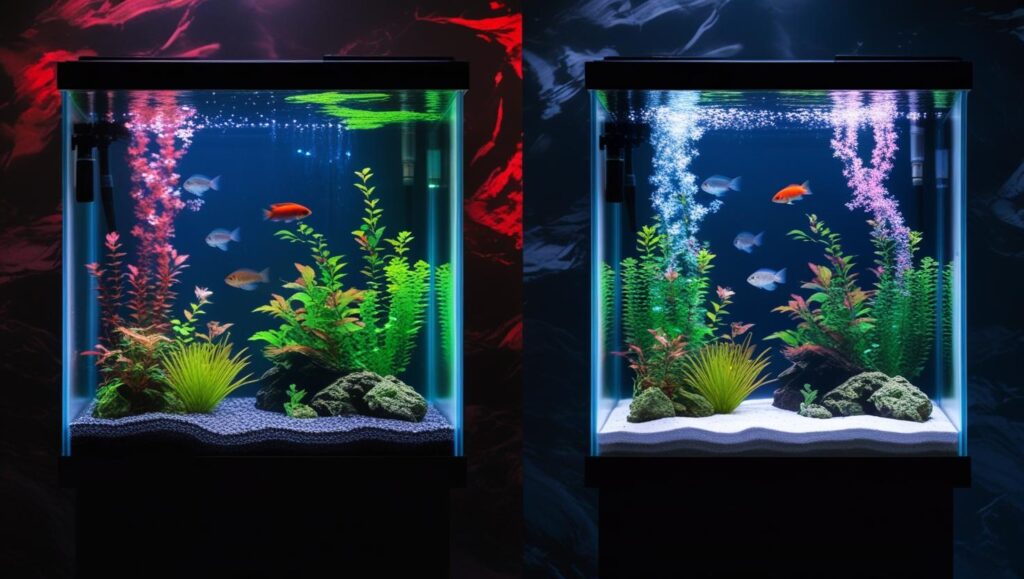
Adding a mirror background to your aquarium is one of those upgrades that looks small but feels huge. It’s more than just a shiny surface. It can completely change how your tank feels and how your fish interact with their space.
Creates the Illusion of Space
A mirror makes your aquarium look bigger. It reflects everything inside, from the plants to the fish, doubling the view and creating a sense of depth. For small tanks especially, this trick can make a huge difference. I remember the moment I stepped back after adding the mirror to my setup, it felt like my 20-gallon tank had suddenly become a 40-gallon. The fish seemed to have more room to swim, even though nothing physically changed.
Enhances Lighting and Reflection
Light bounces beautifully off a mirror. It brightens the entire tank and makes colors stand out more. I use a basic LED light above my aquarium, and after installing the mirror background, the difference was night and day. The greens looked greener, and the scales on my fish caught the light in the most stunning way. Even simple decor started to sparkle. It turned the tank into a visual centerpiece, especially at night.
Adds a Modern Aesthetic
Mirror backgrounds also look stylish. They have a clean, modern vibe that can make your aquarium blend perfectly with your home. Whether it’s next to your bookshelves, in your office corner, or beside your bed, the mirror turns your tank into a piece of living art. I placed mine near a shelf with a few small plants and books, and now the whole corner of the room looks more polished. Guests always ask if I upgraded the tank, it’s that noticeable.
Increases Visual Appeal
Reflections add motion and complexity. As your fish swim, their reflections follow, creating this layered, flowing scene that’s hypnotic to watch. My betta fish often swims right up to his reflection, flaring a little, then gracefully gliding away. It’s entertaining and oddly peaceful. The mirror adds a little extra magic to everyday moments.
How to Create a DIY Aquarium Mirror Background
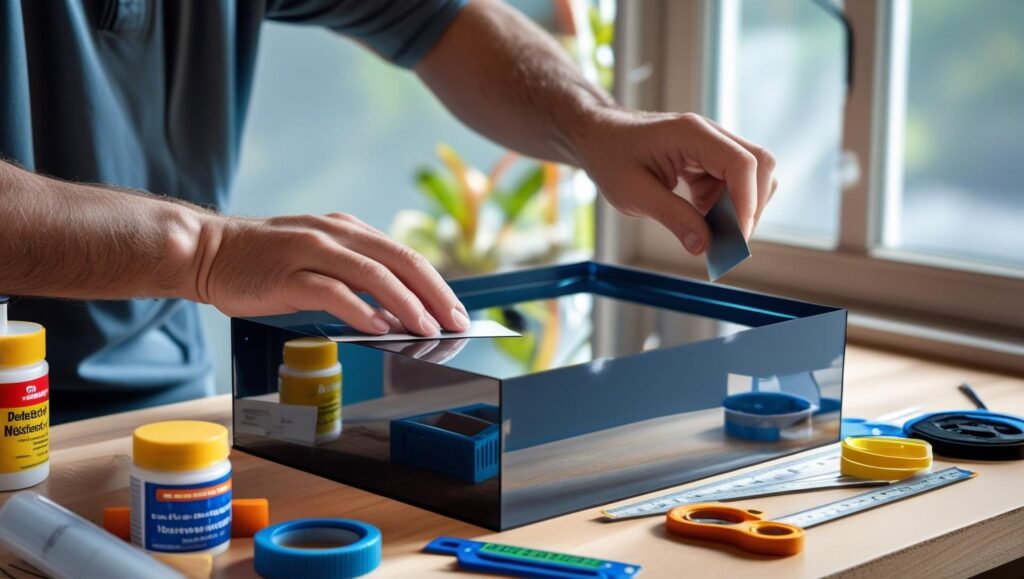
You can absolutely make your own aquarium mirror background at home. It’s easier than you might think, and the results can be surprisingly professional. You just need the right materials, a little time, and some patience. If you enjoy small projects that instantly level up your space, this one’s for you.
Why I Chose to Go the DIY Route
When I first thought about adding a mirror background, I searched online for ready-made options. Some were pricey, and others didn’t fit the dimensions of my tank. That’s when I decided to try doing it myself. I figured, why not give it a shot? If it didn’t work, I wouldn’t be out much money. But honestly, it turned out better than I expected, and it felt good knowing I had made it myself.
Let me walk you through everything you need to get started, along with the exact steps I followed. I’ll also share a few things I learned the hard way so you can avoid the same mistakes.
Materials You’ll Need
To create a clean and safe mirror background, you’ll need the right tools and materials. Here’s a quick overview to get you organized:
| Material | Use |
| Mirror (glass, acrylic, or reflective film) | The actual reflective surface for the background. |
| Aquarium-safe adhesive | To attach the mirror securely without harming fish. |
| Measuring tape or ruler | To ensure accurate sizing for the back panel. |
| Scissors or glass cutter | Depends on the material. Scissors for film, cutter for glass/acrylic. |
| Microfiber cloth | To clean both the tank and the mirror before applying. |
I went with acrylic for mine. It felt safer than glass and more durable than film. I also had it cut to size at the hardware store to save time and effort.
Measuring and Cutting the Mirror
Step 1: Measure the Tank’s Back Wall
Start by measuring the exact width and height of your tank’s back wall. Write it down and double-check. A small error here can lead to annoying gaps or overlaps.
In my case, the tank was 24 inches wide and 16 inches tall. I gave myself about a quarter-inch of wiggle room just to make installation smoother.
Step 2: Cut the Mirror to Fit
If you’re using reflective film, scissors will work fine. For glass or acrylic, you can cut it yourself using a proper tool, or just get it pre-cut. I had the acrylic mirror cut at my local shop. It cost a little extra, but it saved me time and gave me a perfect fit. Totally worth it.
Preparing the Surface
Before you attach anything, make sure the back of the tank is completely clean. I wiped mine down with a damp cloth and then dried it with a microfiber towel. There shouldn’t be any dust, algae, or residue, these can affect how well the mirror sticks.
I also cleaned the mirror itself before applying the adhesive. Smudges might not seem like a big deal now, but once it’s on the tank, they’ll be impossible to reach.
Applying the Mirror to the Tank
Step 1: Use the Right Adhesive
Only use aquarium-safe adhesive. This is really important. Some glues contain harmful chemicals that can leach into the water over time. I used a silicone-based adhesive labeled as safe for aquariums. A small bead along the edges was enough to hold the acrylic mirror securely.
Step 2: Position the Mirror Carefully
Once the adhesive is on, press the mirror gently against the back wall. Start at one side and work your way across to avoid trapping air bubbles.
This part made me a little nervous. I took my time and made sure everything was aligned. It helped to have a friend hold the tank steady while I pressed the mirror into place.
Step 3: Let It Dry Completely
Don’t rush this. Give the adhesive at least 24 to 48 hours to fully cure before adding water or putting fish back in. I left my tank dry for two full days just to be safe. It was tempting to speed things up, but I didn’t want to risk the mirror falling or shifting once the tank was filled.
Once everything was dry, I filled the tank and turned on the lights. The difference was incredible. The tank looked deeper, more vibrant, and more dynamic. The fish swam past their reflections, and sometimes they’d stop and seem to interact with their mirrored selves.
One funny moment: my betta flared at his reflection for a full minute before realizing it wasn’t another fish. He eventually got used to it, but it was a reminder that mirror backgrounds can affect behavior, especially in territorial species.
Best Aquarium Mirror Designs and Ideas
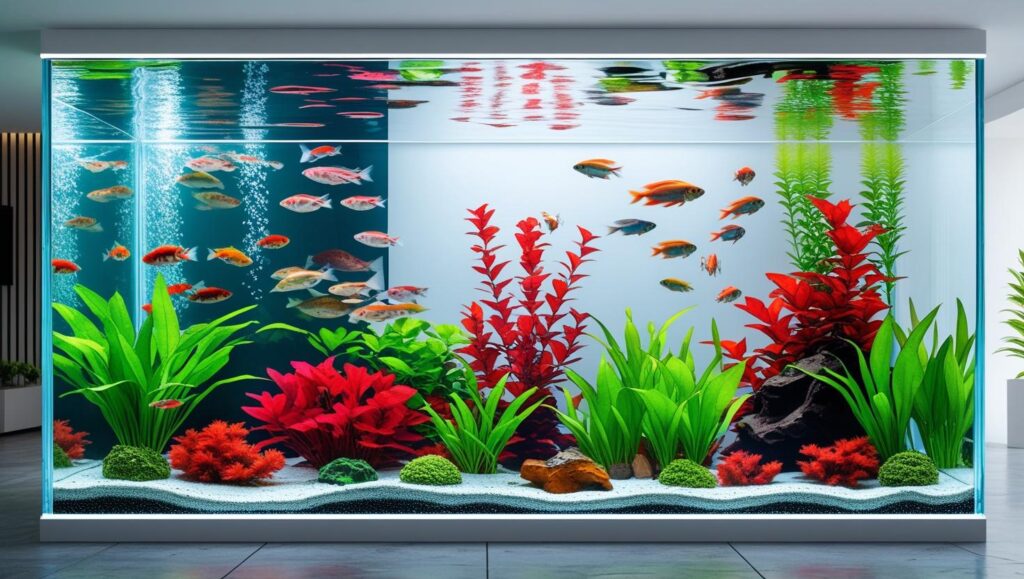
The best aquarium mirror design depends on your tank’s size, layout, and the overall look you want to achieve. Mirror backgrounds can be subtle or bold, minimal or decorative. Each option adds a unique visual element to your aquarium while enhancing depth and lighting.
Full Mirror Background
A full mirror background covers the entire back wall of the tank. This is one of the most popular and dramatic options. It instantly doubles the visual space and reflects everything inside the aquarium. Fish, plants, and decorations appear multiplied, giving the illusion of a larger, more active environment. This design works especially well in smaller tanks, where space can feel limited. It also helps brighten up the tank by reflecting light evenly.
Partial Mirror Setup
A half-tank mirror setup offers a softer, more balanced look. You can cover just the lower or upper half of the back wall. This creates an interesting contrast between the mirrored and non-mirrored sections. It’s perfect if you want some reflection without overwhelming the natural view of your aquarium. The partial design also reduces the chance of confusing your fish, especially in tanks with territorial species like bettas or cichlids.
Framed Mirror Background
For a touch of elegance, consider using a framed mirror background. This design includes a border made from materials like wood, metal, or even PVC. The frame gives the tank a finished, decorative appearance that can match your home’s style. It blends aquarium function with home décor, turning your tank into a visual centerpiece. A framed mirror also hides the edges of the glass or acrylic, offering a cleaner, more refined look.
Modular Mirror Panels
Modular mirror backgrounds are a flexible, DIY-friendly design. Instead of one large mirror, you use smaller mirror tiles or panels arranged in a custom layout. This allows you to mix shapes, sizes, and spacing for a more artistic and unique design. It’s also easier to install and replace individual panels if needed. This style works well for larger tanks or aquascapes with bold, creative layouts.
Choosing the Right Design for Your Tank
When selecting a mirror background, think about the mood you want to create. A full mirror creates bold impact. A partial mirror adds subtle elegance. Framed mirrors blend with interior design. Modular designs offer creativity and control.
Also consider the shape and placement of your tank. Wall-mounted tanks benefit from full mirrors that reflect ambient light. Corner tanks may do better with partial or modular mirrors to reduce glare and confusion for the fish.
No matter which design you choose, the mirror background should complement the tank, not compete with it. The goal is to enhance your aquarium’s natural beauty while adding depth and movement.
Where to Buy Aquarium Mirror Backgrounds
You can buy aquarium mirror backgrounds online or in-store without doing any DIY work. Many retailers offer both standard and custom options to fit your tank size and style. Whether you’re looking for something simple or a more decorative design, there are plenty of choices out there.
Local Pet and Aquarium Stores
Places like Petco, Petsmart, or other local aquarium shops usually carry mirror backgrounds or reflective films made specifically for fish tanks. These are designed to be safe, waterproof, and easy to install. The benefit of shopping in-store is that you can actually see the material, feel its quality, and ask staff for advice. It’s a good option if you’re new to aquariums or unsure which type to choose.
Back when I started setting up my second tank, I stopped by a local aquarium shop to check out their backgrounds. I compared a few samples and even asked if they had anything custom-sized. The staff was helpful, and I ended up picking a lightweight acrylic mirror that was already pre-cut. It saved me time and fit perfectly.
Online Marketplaces
Amazon is a convenient choice for buying mirror backgrounds. You can filter by size, material, and customer ratings. It’s easy to compare prices and styles all in one place. Plus, many products have detailed customer reviews, so you can see real-life photos and read about how the mirror worked in other people’s tanks.
I once ordered a reflective film from Amazon for a smaller tank I keep in the kitchen. It arrived rolled up in a tube, and it took a bit of smoothing out, but it did the job well. The light bounce in that little corner made everything feel warmer and brighter. And when I didn’t like one brand’s finish, the return process was simple.
Custom and Specialty Stores
For those who want a high-end or custom look, specialty aquarium retailers offer mirror backgrounds with unique finishes and premium materials. These stores often work with interior designers or aquarium professionals and can cut the mirror to fit unusual tank sizes or curved glass. While the price is usually higher, the quality and design options are hard to beat.
If I ever upgrade to a larger display tank in the living room, I’d definitely go this route. I’ve seen setups online that look like museum pieces. The mirrored background adds this sleek, polished vibe that standard films or sheets just don’t match.
What to Keep in Mind Before Buying
Always check the return policy before ordering, especially for online purchases. Even if you carefully measure, something might not fit quite right. A flexible return policy gives you peace of mind.
Also, read through customer reviews. They often reveal things product listings don’t, like whether the mirror has a good finish, how easy it is to install, or if it warps over time.
And lastly, think about how the mirror will look in your space. Some reflect too much light or may distract from the aquascape. Try to imagine how it will interact with your tank’s lighting and placement.
In the next part of this guide, I’ll break down the pros and cons I’ve personally experienced after using mirror backgrounds long term, including the small challenges that surprised me after the initial excitement wore off.
Can Mirrors Help Fish Behavior in an Aquarium?
Yes, mirrors can affect fish behavior, sometimes in helpful ways, and sometimes not. While mirror backgrounds add beauty and depth to your tank, they also change how your fish experience their environment. Understanding these effects helps you make a smarter, safer choice for your aquatic pets.
How Fish React to Their Reflections
Fish do not recognize their reflections the way humans do. Many species see their reflection and assume it’s another fish. This can trigger natural behaviors like curiosity, aggression, or social interaction. Whether this is good or bad depends on the species and how long they are exposed to the mirror.
Some fish, especially bettas or cichlids, are territorial by nature. When they see their reflection, they may flare, chase, or try to confront what they think is a rival. This might look entertaining at first, but if it happens too often, it can lead to stress or even exhaustion. For these fish, constant reflection might not be the best idea.
Other species, especially schooling or active swimmers like tetras or danios, may simply be stimulated by the extra movement. The reflection adds more visual interest and can make the tank feel more dynamic. In these cases, the mirror can support enrichment and keep them engaged throughout the day.
Finding the Right Balance
Using a mirror background doesn’t mean your fish will always react negatively. What matters is how you manage it. Start by observing your fish closely in the first few days after installing the mirror. If they seem too aggressive, anxious, or overly focused on the reflection, consider adjusting the setup.
One solution is to use a partial mirror instead of a full one. This reduces exposure and can ease overstimulation. You can also try adding more plants, driftwood, or decor to break up the reflection, giving your fish visual barriers and safe zones.
In one of my earlier tanks, I noticed my betta flaring a little too often. It wasn’t constant, but enough to make me pause. I added a tall piece of driftwood near the center of the tank, and that single change made a big difference. He still swam in front of the mirror occasionally, but the flaring reduced, and his behavior seemed more relaxed overall.
Signs of Stress to Watch For
If a mirror is causing behavioral issues, you may notice some common signs of stress. These include hiding more than usual, darting around the tank, reduced appetite, or clamped fins. Some fish may repeatedly ram the glass or show signs of fatigue.
If you spot any of these, it’s a good idea to either cover part of the mirror or replace it with a non-reflective background. Your fish’s well-being always comes first, no matter how beautiful the reflection might look.
Concluding Remarks
Choosing the right aquarium mirror background can truly transform your tank, making it feel bigger, brighter, and more alive. You’ve learned how different mirror types and designs can enhance both the look and the environment for your fish. This matters because a beautiful, well-thought-out aquarium isn’t just decoration, it’s a space where your fish thrive and where you find daily joy. Remember, it’s not just about style; it’s about creating a healthy, engaging home for your aquatic friends. So go ahead, take that step to upgrade your tank, it’s easier than you think, and the rewards are well worth it.
Quick Answers to Common Questions
- Can a mirror background stress my fish?
Yes, some fish may become stressed if they mistake their reflection for a rival. Monitor behavior and adjust if needed. - Are acrylic mirrors safer than glass for aquariums?
Yes, acrylic mirrors are lighter and less likely to shatter, making them safer around tanks and pets. - How do I clean a mirror background without damaging it?
Use a soft cloth and gentle aquarium-safe cleaner. Avoid harsh chemicals or abrasive tools. - Will a mirror background work with saltwater tanks?
Yes, but choose corrosion-resistant materials like acrylic or specially coated mirrors. - Can I install a mirror background on the outside of the tank?
Yes, external mirrors are easier to install and replace, but internal mirrors offer better visual depth. - Does a mirror background increase algae growth?
No direct effect, but more light reflection can encourage algae. Regular tank maintenance is key. - Can mirrors help shy fish feel more secure?
Sometimes. Reflections may reduce loneliness but could also cause confusion or stress. - Is reflective film as durable as glass or acrylic?
No, reflective film is easier to damage and may peel over time but is budget-friendly and easy to install. - How do I prevent air bubbles when applying reflective film?
Apply slowly from one edge and smooth with a credit card or squeegee to push out bubbles. - Can a mirror background affect water temperature?
Mirrors reflect light but don’t significantly impact water temperature in most setups.

